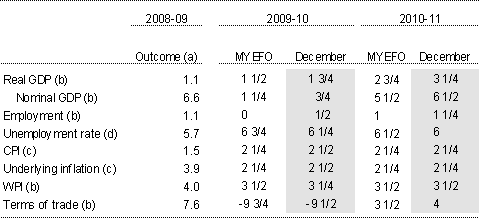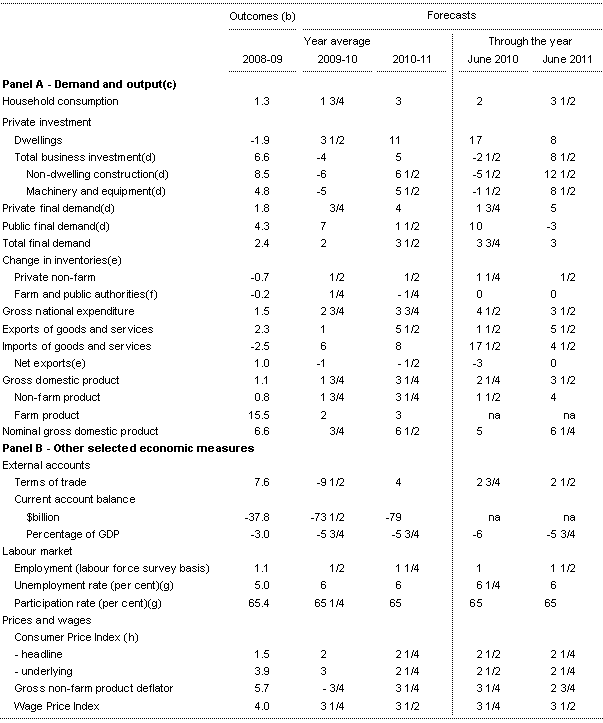The outlook for the Australian economy has improved since the release of the Mid-Year Economic and Fiscal Outlook (MYEFO). This reflects continued improvements in underlying conditions and improved global conditions, which have strengthened the outlook for investment in particular.
Major trading partner (MTP) growth has been revised up by ½ of a percentage point in both 2009 and 2010, and by ¼ of a percentage point in 2011, driven by upgrades to the US, India and other East Asian economies.
The Australian economy is expected to grow by 1¾ per cent in 2009-10, compared to 1½ per cent at MYEFO, while the growth forecast for 2010-11 is stronger at 3¼ per cent. As a result of the improved outlook and strong performance of the labour market, the unemployment rate is now expected to peak at 6¼ per cent in June 2010, half a percentage point lower than expected in MYEFO. The outlook for inflation has been revised up slightly from MYEFO.
While the outlook for the real economy has improved, the forecast for the nominal economy has been revised down by ½ of a percentage point in 2009-10, but is stronger in 2010-11.
Table 1: Key Domestic Forecasts - December compared with MYEFO

(a) Calculated using original data.
(b) Year average.
(c) Through the year growth rate to the June quarter.
(d) June quarter.
Since MYEFO, the flow of data has provided further confirmation of recovery in the global economy. Apart from the United Kingdom, all of Australia's major trading partners expanded in the September quarter, and confidence and activity continue to recover. Export-dependent economies have generally experienced the fastest rebound, as a recovery in world trade proceeds.
While outcomes have been generally better than expected since MYEFO, caution remains as to the strength of the global recovery. Growth in the September quarter slowed in most Asian economies and remained tentative amongst the US and European economies. With employment continuing to trend lower in advanced economies, a durable recovery in private demand has yet to be fully established. Continued slack in labour markets is expected to constrain consumption growth over the forecast horizon along with the ongoing process of financial deleveraging.
The improved outlook both globally and domestically has resulted in upgrades to growth forecasts in most sectors of the economy.
The improved outlook for the global economy will increase demand for Australian exports. This has resulted in a more positive outlook for domestic mining related investment. With a number of larger engineering construction projects now looking more likely to proceed, new engineering and construction investment is expected to grow by around 20 per cent in 2010-11. The rise in the number of large construction projects will increase the demand for capital goods imports. The stronger growth in imports will contribute to a larger current account deficit (CAD) in the coming years as the significant investment required for these projects outweighs domestic savings. However, an expected return to rising terms of trade will provide some offset to the widening CAD.
The outlook for household consumption has strengthened since MYEFO. Retail sales are holding up despite the unwinding of stimulus, and consumer confidence has held up better than expected given recent increases in interest rates. Forecasts for household consumption in 2009-10 have been revised up from a ¾ per cent increase at MYEFO to growth of 1½ per cent. Consumption growth in 2010-11 is also expected to be stronger at 3 per cent.
The near term outlook for the housing sector remains largely unchanged since MYEFO. Dwelling investment picked up in the September quarter (up 5.9 per cent) after three consecutive quarterly declines. Recent housing finance and building approvals data indicate that activity will continue to expand in coming months.
New business investment is expected to fall by 4 per cent in 2009-10 before recovering in 2010-11. Forecasts for 2009-10 have increased from MYEFO as a result of continuing improvement in business confidence and the effects of the Government's tax concessions. New engineering construction investment associated with large mining projects is expected to be strong in 2010-11 and beyond. With strong growth potential in the oil and gas sector and a number of other major resource projects in the pipeline, there is significant upside to the profile of engineering construction investment over coming years.
New public final demand is expected to grow by 7 per cent in 2009-10 and by 1½ per cent in 2010-11. These forecasts are broadly unchanged from the 2009-10 MYEFO. The Government's stimulus measures, which have boosted consumption in recent quarters, are now providing support to dwelling and non-residential investment.
Risks remain around public investment slippage. The quarterly profile has been revised since MYEFO to reflect updated information from jurisdictions on the expected profile of their stimulus spending, which shows further delays in spending.
Export volumes have remained remarkably resilient throughout the global downturn, driven in particular by demand for Australian commodities. Total export volumes are forecast to grow modestly in 2009-10 reflecting the anticipated recovery in the global economy, which will see export volumes strengthen in 2010-11, growing by 5½ per cent.
The forecast for the CAD has increased since MYEFO to 5¾ per cent of GDP in 2009-10 and 2010-11. The widening CAD reflects a widening trade deficit resulting from stronger imports as the economy recovers and the exchange rate remains high. The forecast for the terms of trade is stronger than at MYEFO, decreasing by 9½ per cent in 2009-10. It is expected that stronger than expected world demand will result in higher commodity prices going forward. The terms of trade are forecast to increase by 4 per cent in 2010-11.
The employment outlook has improved in line with the stronger outlook for GDP with the unemployment rate now expected to peak at 6¼ per cent. However, there are some risks to the labour market forecasts. The large fall in hours worked during the downturn may mean that as the economy recovers employers will respond to the extra demand through increasing hours worked rather than increasing employment, resulting in higher unemployment than currently forecast.
The outlook for earnings is broadly unchanged from MYEFO, with moderate wages growth forecast in line with excess capacity in the labour market expected over the forecast period. The WPI is expected to grow by 3¼ per cent and 3½ per cent through the year to the June quarters 2010 and 2011, unchanged from the MYEFO forecasts.
Headline and underlying inflation forecasts have been upgraded marginally since MYEFO, largely as a result of stronger than expected September quarter outcomes. Headline and underlying inflation are now expected to grow by 2½ per cent through the year to the June quarter 2010, up slightly from the 2¼ per cent forecast at MYEFO, and 2¼ per cent through the year to the June quarter 2011.
Overall, the December numbers reflect a slightly more positive outlook than at MYEFO. This mainly reflects stronger underlying conditions as well as an improved global outlook. The main risks going forward are a faltering of the global recovery, slippage in public spending and weak employment growth.
Table 2: Domestic economy forecasts(a)

(a) Percent
age change on preceding year unless otherwise indicated.
(b) Calculated using orginal data.
(c) Chain volume measure.
(d) Excluding second-handasset sales from the public sector to the private sector, and adjusted for the privatisation of Telstra.
(e) Percentage point contribution to growth in GDP.
(f) For presentation purposes, changes in ventories held by privatised marketing authorities are included with the inventories of the farm sector and public marketing authorities.
(g) The estimates in the final two columns are the forecast rates in the June quarter in 2010 & 2011.
(h) Through the year growth rate to June quarter for 2008-09
Source: ABS Cat. No. 5206.0, 5302.0, 6202.0, 6345.0, 6401.0, unpublished ABS data and Treasury.